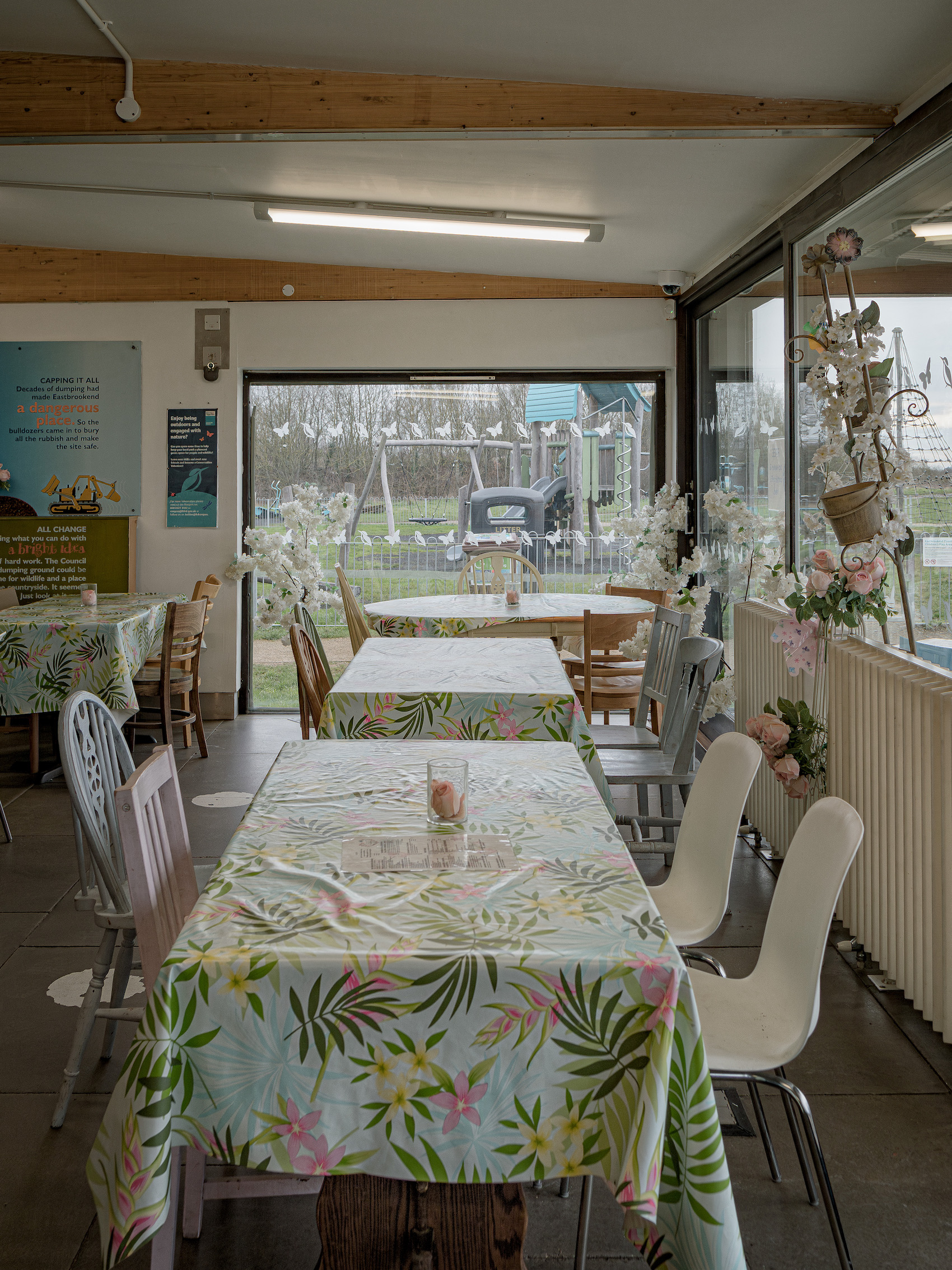Hospitality & Leisure
Eastbrookend Discovery Centre by Perkins&Will
Eastbrookend Discovery Centre in Dagenham was presented at the AT Awards live finals on 18 September 2024. Learn about how the project has stood the test of time.
Eastbrookend Country Park in Dagenham, east London, is a much loved community resource and visitor attraction. Won in competition by Penoyre & Prasad (now Perkins&Will), the two-storey, timber-clad visitor centre houses a café, classroom, display area, and facilities for park rangers.
The building adopts a wedge-shaped profile with a low, largely glazed southern edge and a high north face with selectively positioned windows. This provides an optimal slope for south-facing PV panels, maximises natural ventilation, and creates an appropriate architectural scale and composition upon approach from the road and car park.
Protection from the ever-present threat of vandalism is provided by steel window shutters that can be concealed within the facade build-up, fire retarded timber cladding incorporating an Expamet screen, and an anti-ram raid grass ha-ha.
Designed with the lowest U-values practicable, the envelope, floor and windows achieve 0.16, 0.26, and 1.3 W/m2K respectively. Despite the ‘double-loaded’ ground plan, full cross-ventilation is achieved via ducts above the corridor and a plenum above the north-facing service spaces. In the absence of any wind, diverters in the ducts trigger stack ventilation. The building is also designed to be easily deconstructed with the majority of its materials capable of reuse.
The judges said:
“One of the earliest Millenium Funded projects, Eastbrookend Discovery Centre pre-empted current thinking around low emission heating and ventilation, embodied carbon and design for disassembly and end of life. Impeccable evidence-based, post-occupancy evaluation confirms its on-going popularity and success. Over a quarter of a century after it was built, Eastbrookend is standing the test of time in all the right ways.”
Once a barren no-go area, the former landfill site has been reborn as a ‘microcosm of the countryside’ and a much loved community resource.
Sunand Prasad from Perkins&Will and Jan Britton from Dorset Council explore the genesis of – and sustainable thinking behind – the project.
Jan Britton The building was really born out of a conversation as far back as 1993 when we’d created Eastbrookend Country Park from what were previously landfill sites. It was a very urban site, but one that was a microcosm of the countryside in an area where perhaps few people had access to the countryside in the way others do. The visitor centre looks to the future with a very sustainable design that is trying to embed the message of a new start and fresh opportunity for Eastbrookend – an area that had for 50 years been a tip, a dump, a place not to be accessed because it was dangerous.
Sunand Prasad Sustainability was actually used as a word in the brief, and it was very rare to hear that word at the time. The London Borough of Barking and Dagenham was pretty farsighted in seeing an opportunity at the end of the millennium to use millennium funding to create something which promoted sustainability.
Jan Britton It is nice to see the centre surrounded by trees today. Back in the 90s we were planting these trees on what was then quite a barren landscape. In many respects, the setting grew to the building rather than the building to the setting. That was very much part of our original plan and design.
Sunand Prasad The building touches the ground lightly resting on 23 screw anchors. These were made by AB Chance and were originally intended for guy ropes to stabilise tall masts. But then they realised that they could also be used in compression; and if you screw them down 12, 13, 14, 15 metres into the ground, as they are here, a square inch of steel can take all that weight down to the bearing level. If the building is ever decommissioned, you can simply take the screw anchors out and leave the place as if nothing had ever existed there.
The other thing to say is that with this ethos of touching the ground lightly, even the ground floor is made of dry-laid precast slabs, which can be simply lifted up and removed at the end of their lives. So everything can be reused and recycled as far as possible, and everything is built out of either biomaterials or recyclable materials. We had a series of conversations with the local crime prevention officer who was worried about the aluminum being nicked off the roof. So we put in locking screws. Then he was worried about people chain sawing through the external wooden cladding. So we put chain mesh behind that. Then he was worried about the security of the big glass windows. So we had shutters that closed the whole building up at night. Then he said ram raiders could drive through those shutters. So we created a curving ha-ha at south end of the building so that it would be impossible to charge the building with a truck and then leave the site.
Jan Britton I moved on shortly after the centre opened – there was not much I could do to cap this project, so I looked for a new opportunity elsewhere. The building looks very much like how we left it. I remember you telling me how the timber would weather to a silver colour. I was concerned at the time that it looked very new and stark in a way. But that silvering effect that you described has definitely changed the appearance.
Sunand Prasad 28-years later and the building is used pretty much as planned. The café is much larger than it was, but other than that the building is functioning as intended – not only in terms of its use, but the post-occupancy evaluations that we’ve done over the years show that we pretty much achieved the targets that we set out to achieve in terms of the environmental impact of the construction and the running of the building. At the time, embodied carbon was only just emerging as an issue, but we were conscious of the environmental impact of buildings. We had wanted to use the bill of quantities as a way of measuring carbon impact, but nobody had the software or the means of doing this, and didn’t want to do it long hand. Also, the data wasn’t available for embodied carbon. But since then, we’ve conducted one-click LCA analysis, and it’s a very high performing building in terms of embodied carbon at about 207 kilograms of CO2 equivalent per square-metre of floor area, which is very good by modern standards.
After a stint as a satellite housing department the offices have reverted to use as a ranger service. The café is now larger than originally planned.
Jan Britton At the time we were worried that the viability of a café would be limited, that there wouldn’t be enough visitor footfall to make it a viable proposition in the building. So it’s great to see that situation reverse.
Sunand Prasad There was a period in the building’s history where budgets were very tight and the borough actually shut down the ranger service, and this was used as a satellite housing department for a short time. So in that sense, the building has seen some changes of use, but it’s now thankfully back to being the office for the rangers. Overall, the building has been well received and people have been very positive about it.
Jan Britton Back in the 90s we were unsure what the building would be used for. We were consciously trying to design for flexibility and for different opportunities that might emerge over time. We were trying to work out in our minds, what does a country park visitor centre do in a very urban area? People talk about an eye-catching design and a destination venue, so clearly it’s made its mark. We had no guarantee of this at the time, so it’s good to look back now and say that it has borne the test of time.
Sunand Prasad There are other legacies this building has apart from the most important one, which is for the people of Barking and Dagenham. Braintree District Council was doing a development with Countryside Properties at Great Notley, and they came and said, “We’ve seen your sustainability visitor centre and we want one.” It was a slightly different brief, but this was also built and is still going strong at Great Notley. To wrap up, Transport for London’s poster for the District Line, places this project as the destination at the end of the line, and includes it in its publicity for the Tube, which is a very nice endorsement in its own right.
Other finalists in this category:

Conservation of Blencowe Hall by Donald Insall Associates

The Sekforde Arms, by Chris Dyson Architects
Our awards sponsors
















